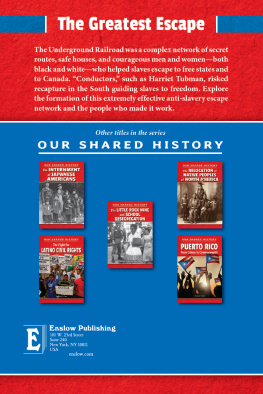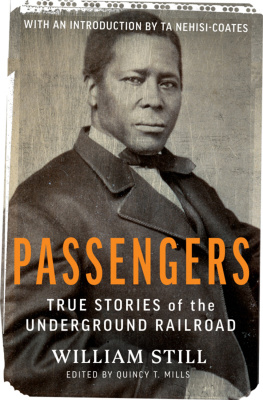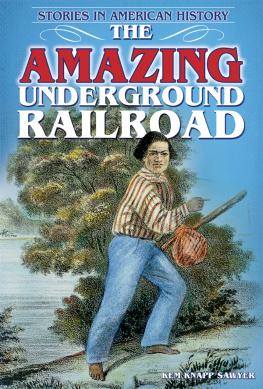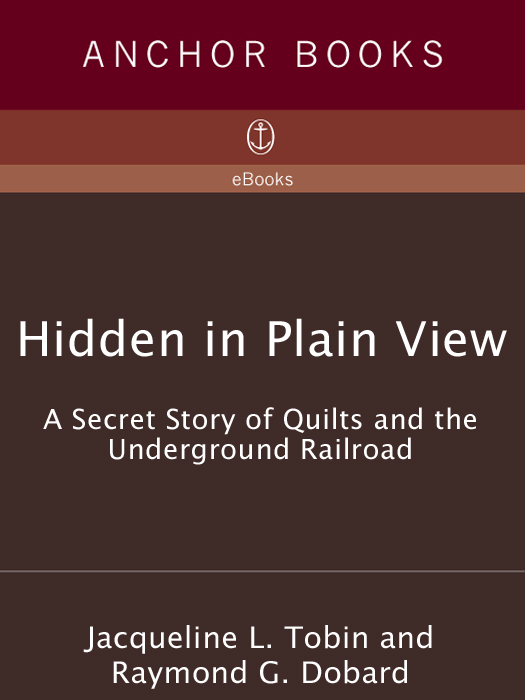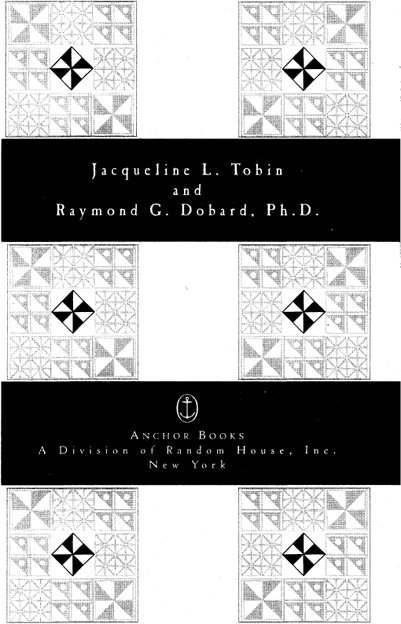
F IRST A NCHOR B OOKS E DITION , J ANUARY 2000
Copyright 1999 by Jacqueline Tobin and Raymond G. Dobard, Ph.D.
The Heritage of an Oral Tradition: The Transmission of Secrets in African American Culture
copyright 1999 by Cuesta Benberry
The Importance of the Decorative Arts in African History copyright 1999 by Floyd Coleman
Secret African Signs Encoded in African American Quilts copyright 1999
by Maude Southwell Wahlman
All rights reserved under International and Pan-American Copyright Conventions.
Published in the United States by Anchor Books, a division of Random House, Inc., New York, and simultaneously in Canada by Random House of Canada Limited, Toronto.
Originally published in hardcover in the United States by Doubleday in 1999.
Anchor Books and colophon are registered trademarks of Random House, Inc.
The Library of Congress has cataloged the Doubleday edition as follows:
Tobin, Jacqueline, 1950
Hidden in plain view / Jacqueline L. Tobin and Raymond G. Dobard
1st ed.
p. cm.
1. Underground railroad. 2. Fugitive slavesUnited States CommunicationHistory19th century. 3. Afro-American quilts Social aspectsHistory19th century. 4. CiphersHistory19th century. I. Dobard, Raymond G. II. Title.
E450.T63 1999
973.7115dc21 98-49804
eISBN: 978-0-307-79056-9
www.anchorbooks.com
v3.1
We dedicate this book to Ozella McDaniel Williams,
to her mother Nora Bell McDaniel, and to her grandmother before her,
for keeping the Underground Railroad Quilt story alive.
And to the memory of everyone who struggled for freedom,
but whose stories have yet to be told.
ACKNOWLEDGMENTS

From Jacqueline L. Tobin
When Ozella McDaniel Williams first told me to write this down, little did I know that she was introducing me to a network of people dedicated to keeping African American history alive. Many of these people have contributed to this book; I am indebted to them all. Persons such as Prince Hall Mason historian Joseph Walkes, Jr., who generously shared his research with me; Elizabeth and Joyce Scott, who described to me the African retentions and personal memories stitched in their quilts and fabric art; the people of the Buxton Township Museum in North Buxton, Ontario, who sent me pictures of slave-made quilts; Deborah Hopkinson and James Ransome, who readily returned letters and phone calls and encouraged me with the story and pictures in their book Sweet Clara and the Freedom Quilt; Arthur Jones, who taught me a great deal and soothed me with his renditions of the spirituals; and Amy Blyth of the Charleston Convention and Visitors Bureau for her support in connecting me to the history of her city.
Stewart, you never questioned my passion for this story and have always supported me in ways that allowed me to follow its threads, wherever it took me. I thank you. B.J., you have been my companion on these sojourns in search of quilters and their stories. You are the keeper of the stories in our family; we are indebted to you. And to my children, Alex and Jasmine, who tolerated my absences and lack of attention, this book is also a gift to you. May you never lack for the stories of your ancestors.
And, finally, to my friend and coauthor Raymond Dobard, for his belief in me and for agreeing to share this journey. Thank you.
Ozella, I stand humbly in front of the mirror, surrounded by your quilts and wisdom. Thank you for entrusting me with your story. I hope this book honors you.
From Raymond G. Dobard
When I said yes to coauthoring this book with Jacki, little did I know how much of my life would be consumed by the story of Mrs. Ozella McDaniel Williams, her intriguing Underground Railroad Quilt Code, quilt patterns, African art and culture, the history of slavery, and African American history. The research and writing of Hidden in Plain View triggered childhood memories of New Orleans and the cultural patchwork of races and religious beliefs that belonged to my African American Creole heritage. I found myself remembering people and customs Id known well, especially the importance of secrets within the black community. Coauthoring Hidden in Plain View enabled me to add to the compelling history of the Underground Railroad. For this opportunity I thank Mrs. Ozella McDaniel Williams and Jacqueline L. Tobin, my coauthor, who invited me to join her in honoring Ozellas story.
I wish to acknowledge the many people who became intensely involved in Ozellas story: from the staff of the Moorland-Spingarn Research Center at Howard University, whose professionalism and human interest were exceptional; to the patience of Saba Cla Williams, a Howard University student, who was the first person to assist me in researching material on the Prince Hall Masons; to my Departmental Chairman, Dr. Floyd Coleman, for his unwavering encouragement; to Mrs. Cuesta R. Benberry, a pioneer in the field of quilt scholarship, who was a mentor and was always there with her encyclopedic knowledge of quilt history; and to Mr. Christian Harrison, a student of design in the Department of Art at Howard University, who generously gave of his talent and time to illustrate the Underground Railroad map.
I express a debt of gratitude to friends and associates like Dr. Leslie King-Hammond, who shared her insight on the work of Mrs. Elizabeth T. Scott and the lukasa tradition; Mrs. Elizabeth T. Scott, who gave of her talent; Ms. Joyce Scott, who remembered her mothers stories; Dr. Robert Cargo for allowing access to his wonderful quilt collection; Dr. Mary Nooter, who helped secure the lukasa image and whose work on African art inspired us; and Mr. Leland Beers of Dresden, Ohio, who took me on a phone tour of his city and described its Underground Railroad station.
The acknowledgments would be incomplete without a special mention of Yawa Book and Gift Shop of Washington, D.C. The name Yawa is an African term of the Hausa people and means abundance. Not only was I to find an abundance of books and knowledge at Yawa, but also another Hausa tradition defined by the word dakasuwa. Dakasuwa, which translates as marketplace, refers to the friendly spirit and exchange of goods, ideas, and caring that is traditional to the African marketplace. Mr. Magaji Bukar, the owner, and his son Mr. Darrell C. Hawkins were there for both Jacki and me from the very beginning of our work. At Yawa, I quickly found what became my place of refuge while writing this book, a spot in front of a window that looked onto the alley and was adjacent to shelves of books on African art and African American culture. For nearly two years that one spot in front of a window invited me to take books from Yawas shelves and to read in a soft quiet light. There I would enjoy solace from a noisy, crowded world. Yawa was my safe house on this publishing journey and for that I am most grateful.



